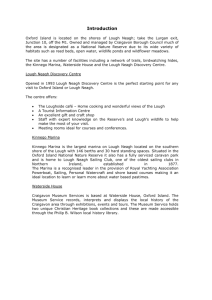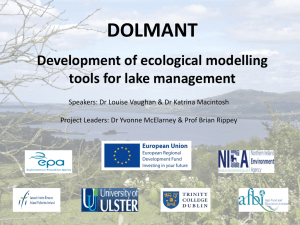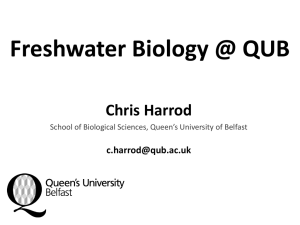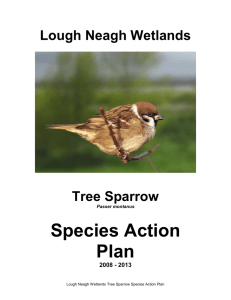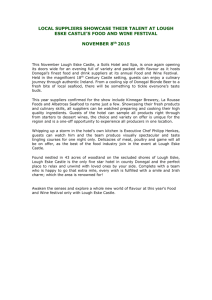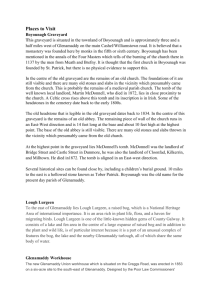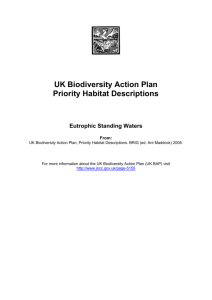5.1. Eutrophic Standing Water Habitat Action Plan
advertisement
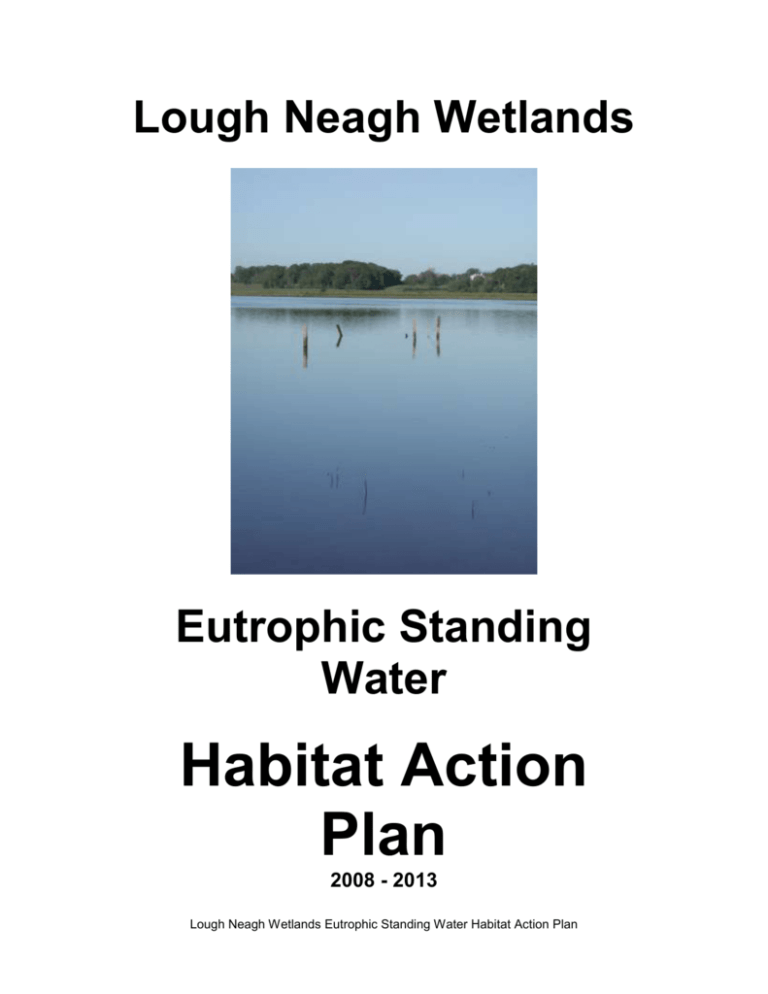
Lough Neagh Wetlands Eutrophic Standing Water Habitat Action Plan 2008 - 2013 Lough Neagh Wetlands Eutrophic Standing Water Habitat Action Plan Eutrophic Standing Water in the Lough Neagh Wetlands Introduction The total Lough Neagh Wetlands covers an area of 82,691ha of which at least 38,818ha (approx. 47%) consists of the open standing waters of Lough Neagh (38,000ha), Lough Beg (476.6 ha), Portmore Lough (184.4ha), Lough Gullion (95.4 ha) and the Craigavon Lakes (61.6 ha). These habitats are considered eutrophic standing waters and, along with their associated aquatic flora and fauna communities, are included in this plan. The two largest open standing waters in Northern Ireland are Lough Neagh and Lower Lough Erne. Lough Neagh is by far the largest area of freshwater in Ireland. It has a drainage basin of 4450 km2, which is shared between Northern Ireland (91%) and the Republic of Ireland (9%). The rivers flowing into Lough Neagh drain about 38% of Northern Ireland, in addition to part of County Monaghan in the Republic of Ireland. Lough Neagh provides water for approximately one third of the population of Northern Ireland. The total surface area of all lakes represents about 4.5% of the total surface area of Northern Ireland. Many lowland water bodies in Northern Ireland are now highly enriched, mainly due to the input of nutrients from point and diffuse sources, with nutrient concentrations far in excess of their natural levels. Open standing waters classed as eutrophic have nutrient levels of more than 0.035 mg l-1 total phosphorus (which includes phosphorus bound up in plankton) and more then 0.5 mg l-1 total inorganic nitrogen (mainly in the form of dissolved nitrates). Lough Neagh is hypertropthic which means that, although it is a naturally eutrophic standing water, levels of nutrients are much higher than they should be, reflecting the impact of human activities in the catchment. As well as elevated levels of nutrient concentrations within the water column of the Lough and its inflowing and out-flowing rivers there has also been a considerable build up of nutrients in the sediments. Hence, even if nutrient inputs to the Lough are controlled, the recovery of the system to eutrophic status will be slow, due to the release of nutrients from abundant sediments. Another feature of these waters is that they have dense, long-term populations of algae in mid-summer, often making the water green. The bed and soil of hypertrophic standing water bodies are covered by dark anaerobic mud, rich in organic matter. The trophic status of a water body dictates which species of plants are able to survive, the species-richness of a lake and its overall biological productivity. In their natural state eutrophic standing waters have high levels of biodiversity. Planktonic algae and zooplankton are abundant in the water column, submerged vegetation is diverse and numerous species of invertebrate and fish are present. Lough Neagh Wetlands Eutrophic Standing Water Habitat Action Plan Background Birds The three largest areas of open water, Lough Neagh, Lough Beg and Portmore Lough make up the Lough Neagh Area of Special Scientific Interest (ASSI) and the Lough Neagh Special Protection Area (SPA). These eutrophic standing waters, and their adjacent habitats, are important for breeding common tern and great crested grebe, and for passage and wintering great crested grebe, whooper swan, golden plover, pochard, tufted duck, scaup, goldeneye, little grebe, cormorant, graylag geese, shelduck, wigeon, gadwall, teal, mallard, shoveler, coot and lapwing. Marginal habitats of these lakes are highly dependent on the adjacent open water body in terms of lake water levels and the nutrient status of the water. These marginal habitats hold important breeding wader and wildfowl populations including snipe redshank, lapwing, curlew and shoveler. Fish Atlantic salmon migrate from the Atlantic Ocean, up the Lower River Bann and into Lough Neagh. This migration can take place during any month of the year but is particularly pronounced in late summer and early autumn. Eggs are laid in the gravel beds or ‘redds’ and hatch there in late March or early April. The newly hatched fish, known as alevins, spend the next four or five weeks in the gravel before finally emerging as fry. Juveniles then utilise the streams as nurseries for the next one, two or occasionally three years as parr before turning into smolts and migrating to sea during the spring to complete the life cycle. Lough Neagh supports the largest population of the glacial relict pollan in Ireland. It is reported that around 25% of the Lough Neagh biomass consists of this species. The pollan is distinct from all other European species of whitefish (Coregonus) and is elsewhere known only from eastern Siberia and northwestern North America (Alaska Cisco). It is a Northern Ireland priority species and a species of conservation concern. Pollan have been fished for food in Lough Neagh for centuries and are still fished commercially, forming an important component of the Lough eel and perch fishery, although the catch is small in comparison with former times. The species also occurs in Lough Erne and the Shannon lakes but is much rarer there. They spawn in the stony substrates of the Lough from early November to late December. The Lough Neagh Wetlands Local Biodiversity Action Plan had originally selected pollan as a species for which a Species Action Plan would be produced. After further consultation with relevant stakeholders it was decided not to produce a separate plan, because an All Ireland Plan already existed and was being delivered at local level within the Lough Neagh Wetlands. Instead, it was decided to include action for the species through this habitat action plan. The dollaghan, a migratory form of brown trout, is found in Lough Neagh. This species migrates from Lough Neagh into its inflowing and outflowing rivers to Lough Neagh Wetlands Eutrophic Standing Water Habitat Action Plan spawn, and is considered to be unique to the Lough. Lough Neagh trout are split into two forms – Dollaghan and Salmon trout. Salmon Trout are silver coloured with large heads and few black spots and no red spots. Dollaghan Trout are small headed with many black spots and a brown body. In the past they were divided into three distinctive forms: the river trout Salmo trutta L, the common trout Salmo fario L (of which the gillaroo trout – with large spots was considered a distinct variety) and the great lake trout Salmo ferox L. The eel is native to Ireland and is subject to great phenotypic variation. After crossing the Atlantic Ocean as young eels (known as leptocephali) they change into elvers and ascend into freshwater during the spring months. They then live in freshwater for at least seven or eight years during which time they are called yellow eels and grow to over 40cm in length, during which time they are subject to harvesting in Lough Neagh. After this time the eels turn silvery in appearance and stop feeding prior to their seaward migration during autumn and early winter to complete their life cycle somewhere in the Sargasso Sea. During migration silver eels are also captured along the Lower Bann as part of the Lough Neagh Eel Fishery. The silver eel fishery, along with the yellow eel harvest on the Lough itself, combine to make the Lough Neagh Eel Fishery one of the largest and most commercially important in Europe. Eel numbers have declined in recent times across Europe, and this has been evident in Lough Neagh. Fish communities in eutrophic standing waters are a mix of coarse and salmonid species, but today there are few lakes with truly natural assemblages due to mixing with introduced coarse fish such as roach, rudd, gudgeon, perch, bream, pike and tench (tench being rare in Lough Neagh). Several introduced fish species have been established and have become an accepted part of the biodiversity associated with standing open water and many Loughs are now dominated by introduced roach. Invertebrates Dragonflies, water beetles, stoneflies and mayflies are well represented in eutrophic lake habitats. Bottom-dwelling invertebrates such as snails and the larval stages of non-biting midges, dragonflies, stoneflies, mayflies, water beetles and shrimps such as Mysis relicta are abundant. Plants Characteristic aquatic plants of eutrophic lakes and ponds vary with geographical area, nutrient concentrations and exposure and include duckweeds, white waterlily, yellow water-lily and spiked water-milfoil. Submerged aquatic plants are usually rare or are restricted to shallow waters owing to poor light penetration. Plants with a restricted distribution in Northern Ireland occur in the open standing waters of Lough Neagh, such as slender-leaved pondweed. Lough Neagh Wetlands Eutrophic Standing Water Habitat Action Plan Threats Water Quality Eutrophication is the biggest threat to water quality in the Lough Neagh Wetlands, mainly due to the release of nutrients from point and diffuse sources of pollution. Point-source pollution is polution that can be traced back to a single origin or source such as a sewage treatment plant discharge. Diffuse Pollution comprises true non point source contamination and pollution arising from a multiplicity of dispersed, often individually minor, point sources. Examples of true non point sources are run-off from fields or seepage of nutrients from soil into ground water. Examples of minor point sources are field drains or surface water drains in urban areas. Diffuse sources are often individually minor, but collectively significant. Phosphorus enrichment stimulates growth of phytoplankton and hence makes the water cloudier. This reduces light penetration in the water column and restricts many of the submerged plants that grow underwater. The increased biomass of phytoplankton also depletes the water of dissolved oxygen through respiratory demand when algal cells are deprived of light (e.g. at night, or when they are found in low-light regions of the turbid water column) or when they die and undergo decomposition. Agricultural activities can cause pollution of water bodies through poor waste storage facilities and inadequate separation of contaminated yard water and clean water. Inappropriate application of slurry and inorganic fertilizers during adverse weather conditions, on steeply sloping land, or the over-application of these can result in loss of phosphorus to waterways. This is commonly referred to as diffuse pollution. Inappropriately treated discharges from waste water treatment works (WWTW), industrial sites and septic tanks can be point source of nutrient enrichment of open standing waters. Contaminated groundwater sources that feed surface waters can also contribute to the nutrient loadings of open standing water. Ploughing up grassland and other habitats surrounding open standing water, drainage and overgrazing can all increase the possibility of soil erosion with a consequent increase in water-borne sediments. Settled sediments may continue to introduce nutrients into the water column. Sediments in suspension cause turbidity and the resulting light attenuation may inhibit the growth of rooted aquatic plants in the spring, increasing the changes of algal dominance. Lough Neagh Wetlands Eutrophic Standing Water Habitat Action Plan Water Levels If water levels in open standing water are low during the spring salmon run, fish cannot get into rivers to spawn. All fish movements and migrations depend on adequate flows. Low water levels can also cause important wetland habitats, such as marshes and wet woodlands, to dry out. Arterial drainage schemes have had an effect on the hydrological balance of the open standing water of Lough Neagh and its associated satellite lakes. The maintenance of drainage schemes continues to have the potential to directly affect lake water levels and indirectly affect peripheral wetland habitats such as fens, reedbeds and floodplain grazing marsh and their associated rare wetland flora and fauna. Although Rivers Agency only maintain the current land drainage function of designated watercourses, riparian drainage works are not controlled through the Agency and could have a detrimental effect on this habitat type. That is because these are drainage works on non-designated channels carried out by the landowner. The only controls would be if the drain was in a designated site by which he would need to apply to EHS for consent, he was a farmer within a CMS, LFA or single farm payment by which there would be DARD guidelines regarding the management of drains or sheughs, or he wanted to culvert the drain in which case he would require planning permission. Rivers Agency would only become involved if the landowner is not maintaining the flow of water and is causing problems upstream to a different landowner. Dredging and the clearance of bankside vegetation as a result of flood control works can also affect downstream water quality by increasing suspended sediment loads and nutrient concentrations, and water quality by allowing water to flow more quickly. Non-native Species Deliberate or accidental introduction of non-native invasive species such as Zebra mussel can have a damaging effect on the native flora and fauna of open standing water due to the direct effects of competition or indirectly by altering the natural habitat of native species. Zebra mussels were first recorded in Lough Neagh in 2005. This species is able to attach to and form large colonies on any submerged hard surface. Fouling growths can swamp the spawning grounds of lake spawning salmonids. They are very effective filter feeders and can virtually strip the water column of zooplankton and phytoplankton leading to increased water clarity, although this does not result in a net loss of nutrients from the system. Zebra mussel grazing of photoplankton can influence the structure and abundance of the zooplankton community thus modifying food from zooplantivorous species and life stages (e.g. larval and juvenile) of fish. They also shift the bulk of biological systems from pelagic to benthic systems associated with mussel beds. Fish introductions can significantly alter the food Lough Neagh Wetlands Eutrophic Standing Water Habitat Action Plan web in lakes which can impact on the overall ecological status of lakes. For instance, roach were first introduced to the Lough Neagh catchment in the mid 1970’s and are now one of the dominant species in the lough. In addition, fish stocking can have specific impacts on genetic integrity of established fish populations such as native populations of brown trout. Climate Change The predictions for climate change include increased summer temperatures and milder, wetter winters. These changes may result in drier summer conditions, with extended growth periods during the winter. It is unclear how eutrophic standing waters will respond to such changes but it is known that pollan are coldadapted Arctic species and that increases in summer water temperatures above a certain limit are likely to be detrimental to that species. Man-Made Litter Large quantities of litter are deposited each year all around the shores of Lough Neagh and the other open standing water sites, as well as along the watercourses that discharge into them. A further threat to the biodiversity of eutrophic standing water comes from the build up of lead shot, caused by the hunting such as wildfowling. Species such as dabbling duck and swans can digest this substance and die from lead poisoning. Public Amenity The open standing waters of the Lough Neagh Wetlands are an important visual and aesthetic resource and can have considerable amenity value including bathing, fishing, shooting, boating and other water sports. These activities if not managed sustainably can have a negative impact on biodiversity, for example live baiting and uncontrolled introductions of fish for angling and uncontrolled jet sking near nesting sites. Opportunities Water quality projects Develop Sustainable Drainage Systems to protect, enhance and conserve wetland species and habitats via River Basin Management Plans and Nutrient Management Plans for areas influencing Eutrophic Standing Water. Several reed bed filtration projects are underway at the Washing Bay , Oxford Island and at Greenmount College to treat water from septic tanks and from farmyards. This biological treatment of water reduces nutrient levels and contributes to the local action to restore eutrophic standing water habitat. The Lough Neagh Wetlands is part of the Neagh-Bann International River Basin District. The EU Water Lough Neagh Wetlands Eutrophic Standing Water Habitat Action Plan Framework Directive is being delivered in throughout this district with the first phase being implemented up to 2015. The Water Framework Directive aims to achieve good status and preserve our best waters. To achieve this, a River Basin Management plan will be prepared and implemented. A draft plan will be issued in 2008 with the final version due to be published by the end of 2009. Captive breeding for pollan The Department for Arts, Culture & Leisure (DCAL) has developed the capabilities to breed pollan in captivity. The technology is therefore available to take pollan from Lough Neagh, breed them in captivity and create a back-up genetic stock of the species in another suitable lake. Having a back-up stock would allow for future re-stocking of the species in Lough Neagh if this was required. Reduce impact from lead shot Raise awareness about the threat posed by the use of lead shot over wetlands, and lobby for the introduction of a ban on the use of lead shot over wetlands. Habitat creation and restoration Develop a programme focused on the creation and management of ponds on private and public land in the Lough Neagh Wetlands Wildfowl Refuges Working in partnership with the wildfowlers of the Lough Neagh Wetlands, establish more wildfowl refuges Clean-up campaign Working with various groups around Lough Neagh shores, co-ordinate the clean up of the shore on an annual basis. Access and Interpretation at Local Nature Reserves Provide access and interpretation to promote the Local, National and International importance of the open water habitats of the Lough Neagh/Beg area. Five Local Nature Reserves are being established in the Lough Neagh Wetlands to raise awareness of the importance of eutrophic standing water for biodiversity. These are located at Portmore Lough, Traad Point, Ballyronan Wood, The Washing Bay and Craigavon Lakes. Local Nature Reserves are managed by Local Authorities in partnership with the local communities of these areas. Advice Produce simplified user-friendly best practice guides for local farmers and developers in the surrounding catchment area, using information similar to that contained within the Ministery of Food & Agriculture’s Best Practice Guides – Code of Good Agricultural Practice for the protection of Water, Code of Good Lough Neagh Wetlands Eutrophic Standing Water Habitat Action Plan Agricultural Practice for the protection of Soil, and Good Practice Guide for Handling Soils (see Annex A) Lough Neagh Wetlands Eutrophic Standing Water Habitat Action Plan (Eutrophic) Open Standing Water Objectives & Targets Objectives & Targets OBJECTIVE TARGET ESW/01 Identify & Map open standing water within the Lough Neagh Wetlands 2008 ESW/02 Maintain and restore the biological diversity of Eutrophic Standing Water in the Lough Neagh Wetlands 2013 ESW/03 Create Open Standing Water habitat in Lough Neagh Wetlands 2013 EWS/04 Raise awareness of the value of this habitat for biodiversity 2013 Lough Neagh Wetlands Eutrophic Standing Water Habitat Action Plan (Eutrophic) Standing Water - Action Actions ACTION LEAD PARTNER RBLNA PARTNERS TO BE ACHIEVED BY 31st Dec: 2008 OBJECTIVE S MET ESW/02 EHS LNAC / LNP 2008 ESW/02 / ESW/04 ESW/A1 Produce a management plan for breeding duck on Rams Island ESW/A2 Promote the EHS Pollution Hotline at a local level via 5 article/media events (1 per year) ESW/A3 Promote the DARD Code of Good Agricultural Practice for the Prevention of Pollution of Water, Soil and Air. DARD LNAC / LNP / CBC 2008 ESW/02 / ESW/04 ESW/A4 Write 1 article to highlight the threat of lead shot to biodiversity and encourage a phase out over eutrophic standing water LNAC BASC / EHS / LNP / CBC 2008 ESW/04 ESW/A5 Establish a habitat creation programme to create and restore ponds in the Lough Neagh Wetlands LNP 2009 ESW/02 / ESW/03 ESW/A6 Create 3 new initiatives which employ sustainable water management techniques such as constructed Wetlands, rainwater harvesting and green roof to address water quality issues associated with surface run off, monitor water quality in affected watercourses and report results Carry out a co-ordinated clean-up along the Lough Neagh/Beg Shore every two years LNP DARD / EHS / FWAG / LNAC / Rivers Agency / CVNI / CBC EHS LNAC 2009 ESW/02 BASC / LNAC / MDC / CDC / D&STBC / CBC / LCC / ABC / BBC 2009 ESW/02 ESW/A7 LNP EHS / LNP / LNAC Lough Neagh Wetlands Eutrophic Standing Water Habitat Action Plan / CVNI / QPANI ESW/A8 Confirm the trophic status of all standing waters of more than 0.2 Ha in the Lough Neagh Wetlands and map all sites on GIS LNAC EHS / LNP / CBC 2009 ESW/01 ESW/A9 Map the location of all standing water bodies up to 2 ha (drumlin lakes, ponds & pools) and use this database to protect habitats from development pressures Provide a birdwatching facility with interpretation at Randalstown Forest next to Farrs Bay NNR, Lough Neagh LNAC EHS / LNP / 2009 ESW/01 ABC / LNP / LNAC / RSPB / Arches Community Group MDC / LNP / LNAC / RSPB BASC / LNAC / LNP / CBC 2009 ESW/04 2009 ESW/04 2010 ESW/02 EHS LNAC / LNP / / CBC 2010 ESW/02 LNP DARD / EHS / FWAG / LNAC / Rivers Agency / RSPB / CVNI / CBC EHS / LNAC / CBC 2010 ESW/04 2010 ESW/04 EHS / LNP / MDC / CDC / D&STBC / CBC / LCC / ABC / BBC 2010 ESW/04 ESW/A10 ESW/A11 ESW/A12 ESW/A13 ESW/A14 ESW/A15 ESW/A16 EHS Create access, interpretation and viewing facilities at Longpont, Lough Beg NNR Develop a partnership with Lough Neagh Wetlands wildfowlers / hunts people and address the threat posed by the use of lead shot over eutrophic lakes Establish 1 new refuge at a biodiversity hotspot in Lough Neagh/Beg, or extend the size of 1 existing refuge / zone at a biodiversity hotspot in the Lough Neagh Wetlands, to reduce disturbance to biodiversity Establish 1 Demonstration Site to transfer knowledge about the creation and management of open water habitats, and hold 1 onsite event every two years EHS Establish 1 Demonstration Site to transfer knowledge about methods used to address water quality issues associated with surface run off, and hold one on-site event every two years Provide co-ordinated interpretation at all access points around the Lough Neagh/Beg Special Protection Area to promote the National and International importance of the wetland for biodiversity LNP EHS LNAC Lough Neagh Wetlands Eutrophic Standing Water Habitat Action Plan ESW/A17 Hold 5 educational events (1 every 2 years) at an open standing water site to promote the importance of the habitat for Biodiversity RSPB ESW/A18 Press for regular checks to be carried out on all septic tanks in use in the Lough Neagh Wetands, and action to be taken to prevent pollution found to be emanating from this source LNAC ESW/A19 Raise awareness, on an annual basis, among agri-environment scheme advisors of the need to promote the take-up of agrienvironment options that benefit eutrophic standing water and associated priority species in the Lough Neagh Wetlands. LNAC EHS / LNAC / Local Authorities / LNP / CBC EHS / Local Authorities / LNP 2013 ESW/04 2013 ESW/02 DARD / EHS / FWAG / LNP / RSPB / CBC 2013 ESW/04 Lough Neagh Wetlands Eutrophic Standing Water Habitat Action Plan Lough Neagh Wetlands Eutrophic Standing Water Habitat Action Plan Lough Neagh Wetlands Eutrophic Standing Water Habitat Action Plan
